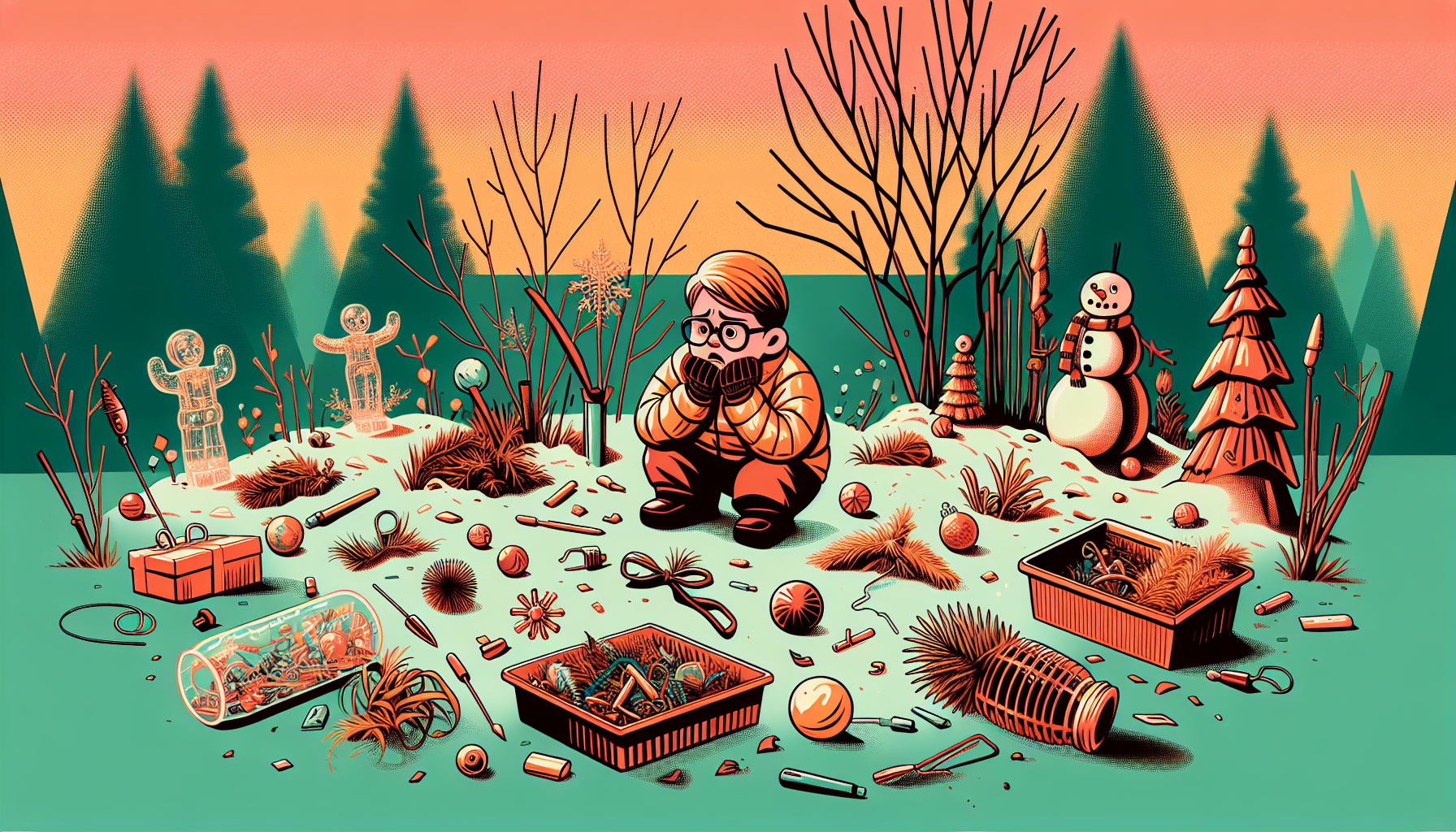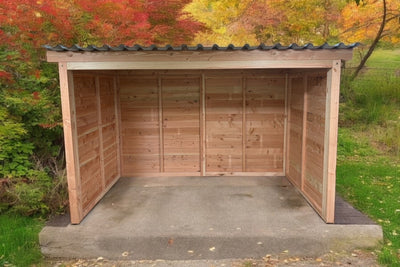Plastic-free winter decorations in the garden: Ideas for a natural oasis
When the temperatures drop outside and fog lies over the flower beds, many people want an atmospheric winter garden without plastic. Instead of leaving the outdoor area to its own devices, use natural materials to create a peaceful, natural winter oasis that suits the climate and light conditions in this country. In this way, you can protect nature, inspire children to adopt mindful routines and avoid unnecessary waste - with ideas that work even in snow, breezes and permafrost.
In this guide, you will learn how to decorate your garden consciously and regionally in winter without resorting to plastic. We show you suitable natural materials, simple DIY projects for families and important safety tips for children and animals. This will turn your garden into an eye-catcher and contribute to greater sustainability at the same time.
Why is plastic-free decoration important in winter?

Environmental impact of plastic in the garden
Weatherproof plastic breaks down into microplastics due to UV radiation and frost, which end up in soil and water and remain there for a long time. The Federal Office for the Environment therefore recommends consistently reducing plastic inputs - a strong argument in favor of winter garden decorations without plastic. Up-to-date information on macro- and microplastics can be found at the FOEN.
Many decorative elements fade, become brittle and end up in the garbage or as litter in hedges and stream banks. This pollutes the soil, endangers wildlife and disfigures paths and neighborhoods. Natural alternatives avoid these problems from the outset.
Advantages of natural materials
Wood, cones, moss, bark, dried fruit and beeswax are regionally available, biodegradable and have a particularly atmospheric effect in winter. Glass as a lantern, stone slabs or tree slices serve as stable, reusable bases. This creates a warm atmosphere that blends harmoniously into the garden landscape.
When crafting with children, natural materials also score points for their pleasant feel and low risk of injury. If something falls to the ground, there is no danger to animals and many elements can be creatively reused over several winters.
Which materials are suitable for winter garden decorations?
Popular natural materials for decoration
Most can be found on your doorstep: on walks, in the woods or in your own garden. For a long-lasting, flexible design - and as a basis for winter garden decorations without plastic - are particularly suitable
:- Pine cones, branches and twigs: wreaths, garlands, window and fence decorations; the needles are fragrant and add texture.
- Tree slices and bark: bases for tea lights, name tags or hanging elements.
- Dried fruit: apple and orange slices and cinnamon sticks add color accents.
- Beeswax and candle scraps: For homemade lanterns or scented candles in jars.
- Fabric scraps, wool and jute: For bows, pendants and hanging decorations.
Paper, cardboard or old wood can also be upcycled. Look out for compostable or reusable materials and strong, moisture-resistant bonds.
Local availability of materials in Switzerland
Collecting materials regionally is good for your budget and the environment: branches, larch cones and pieces of bark can usually be found in sufficient quantities in the Central Plateau, Jura foothills and foothills of the Alps. Quantity. Collect within the usual local limits and respect cantonal rules - you can find information on the right to enter and collect freely here.
Weekly markets, farm stores and unpackaged stores often offer dried fruit, spices and candles made from beeswax in late fall. This keeps the design authentic and supports local suppliers.
How do I create safe and child-friendly winter decorations?
Tips for planning with children
Crafting together combines experiencing nature and creativity - ideal on short winter days. Start with simple projects such as painting cones, threading orange slices or tying branches; this way the decoration grows step by step into a winter decoration garden without plastic. Plan short work steps, warm breaks and clear tasks for small hands.
Choose robust materials that are pleasant to the touch and avoid using solvent-based paints. Natural paints, chalk or casein paint are sufficient for many applications and are easy to work with outdoors.
Safety aspects of the materials used
Tip Deburr branches, wrap wire ends neatly and only use naked flames in fireproof jars. Never leave candles outside unattended; rechargeable LED tea lights or solar lamps with warm light are safer. Only use electric fairy lights with an outdoor protection class and a splash-proof power supply unit.
Anyone integrating fruit or seeds should follow professional recommendations to ensure that birds stay healthy and no bad food ends up in the snow. BirdLife Switzerland offers practical tips on feeding birds in winter.
What sustainable ideas are there for winter garden projects?
DIY projects for families and children
With little effort, you can create long-lasting eye-catchers that don't require new plastic - perfect for winter garden decorations without plastic. Try the following ideas, which are also successful in cold weather and can be combined well
:- Branch stars: Tie five branches of the same length to form a star; secure the knot with jute and add a slice of branch to the middle.
- Lanterns: Decorate empty jam jars with twigs, leftover wax and dried fruit; place on tree slices.
- Ice lights: Freeze water with berries and twigs in bowls; arrange as temporary lights in case of frost.
- Spice wreaths: Thread orange slices, laurel, cinnamon and twigs onto wire; hang up protected from the weather.
Such crafting sessions can be combined with tea and music. This keeps motivation high and the decorations grow in a controlled and weatherproof manner over several weeks.
Designing feeding places for birds and other animals
Feeders can be integrated decoratively and help during periods of frost. Feeding silos, apple halves on strings and home-made mixtures of seeds, oat flakes and a little fat are suitable. Pay attention to hygiene and cat-proof placement; BirdLife also points this out.
- Shape homemade dumplings without plastic nets and hang them in wire spirals or branches.
- Offer dried fruit in portions and replace it regularly so that nothing spoils.
- Incorporate nesting aids and insect hotels as decorative elements and install them out of the wind.
Avoid coated ready-made products with synthetic netting. This way you avoid the risk of injury and keep the design consistently plastic-free.
How do I look after my winter decorations and avoid common mistakes?
Long-term care of decorations
Weather-resistant natural materials last a surprisingly long time if they are placed correctly. Delicate pieces should be placed under canopies or against windless house walls; this way, your winter garden decoration will stay beautiful for longer without plastic. Lanterns Always place on level, non-flammable surfaces such as stone tiles or tree grates.
Check regularly: Lightly moisten moss when dry, replace spoiled fruit and tighten loosened knots. At the end of the season, many materials can be composted or stored dry for later projects.
Common mistakes and how to avoid them
Mixing natural materials with plastic decorations looks inconsistent and makes disposal more difficult. Avoid touching the ground with delicate DIY pieces; moisture promotes mold and shortens shelf life. Hanging arrangements or raised stands are better.
Note the load-bearing capacity of jute, wool and hemp rope when wet. Replace soaked ribbons in good time or use protected natural wire. This will keep the decoration safe and in good condition.
Costs and budgeting for plastic-free winter decorations
Realistic cost estimate
Many materials are free: Collecting, upcycling and swapping in your neighborhood will significantly reduce your budget. Accessories such as jute twine, beeswax, natural paints or jars usually cost between CHF 20 and 80 - depending on the scope and reusability of your plastic-free winter garden decoration. If you opt for long-lasting elements, you will save considerably in subsequent years.
Farm stores, markets, unpackaged stores and second-hand shops offer suitable natural materials and containers. Second-hand finds can be added online via Ricardo or Tutti; repair workshops and repair cafés help with refurbishing.
Tips for saving money on decorations
- Reuse leftovers from the Christmas season such as natural candles, orange slices and fir branches.
- Collect and swap materials together - ideal with neighbors or in a club.
- Organize neighbourhood swap tables or crafting sessions and share tools.
- Use preserving jars, fabric scraps and old wooden boards as a stable crafting base.
Community activities with schools, clubs or neighborhoods make larger projects possible with little effort. At the same time, they promote knowledge transfer and exchange.
Conclusion: Winter garden enjoyment without plastic is possible
An atmospherically decorated winter garden does not need plastic, but rather good ideas, regional materials and clear safety rules. With a carefully planned winter garden decoration without plastic, you can create atmosphere, protect nature and animals and give children meaningful tasks.
Start your garden project now: collect materials, make your first lanterns and decorate step by step. For background information on microplastics, we recommend the FOEN; practical winter feeding tips can be found at BirdLife. More joy in the garden starts today - start your garden project now.
FOEN: Plastics in the environment | BirdLife Switzerland: Bird feeding | Free access and collecting in the forest


